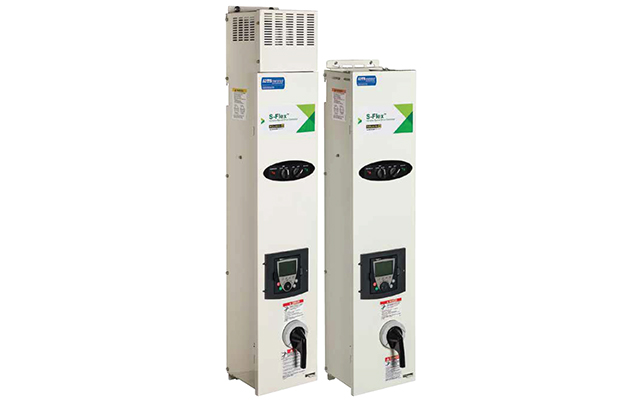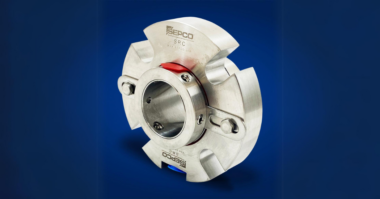Author: Robert Gray, Schneider Electric
The use of Variable Frequency Drive (VFD) technology for HVAC/R equipment has long been established. The simple math of reducing the speed of a motor driving a supply or exhaust fan proves out in delivering substantial energy savings potential. Incorporating feedback mechanisms such as static pressure sensors for maintaining proper duct static in VAV air distribution, has proven to be a simple application that delivers optimum energy savings without sacrificing comfort in the building space.
Out of the necessity to dig deeper into the control of HVAC/R equipment to achieve additional energy savings, VFD technology has moved on to more complex applications. To safely vary the speed of a refrigeration compressor requires much more feedback into the controller prior to reducing the speed of the compressor. It is very important that the controller be equipped with the proper control algorithms within the software to safely control the compressor.
Applying a VFD for compressor control on a refrigeration system, should provide the following:
- Reduce the energy usage/ operating costs
- Extend the Useful Life of the equipment
- Less variance from the cooling setpoint temperature
Perception within the HVAC/R Industry is that VFDs have had an up and down history of success in controlling the compressor speed. Many Mechanical Installation Contractors have learned the hard way that it may not be just a “simple” installation. Where you have remote condensing units, and if your refrigerant lines are not installed properly to allow for adequate oil return to the compressor, you are at a risk of premature compressor failure, right off. This is true for even a constant speed compressor. For this article, we will assume proper mechanical installation of the AC system has occurred.
Reducing the speed of the compressor should extend its useful life, not result in it’s premature failure. Without advanced algorithms within the controller’s software, you could (and probably will) cause the compressor to fail prematurely, and there goes your energy savings.
It is not as simple to control the speed of a compressor as compared to controlling an air-side product such as a supply fan. There is much more at stake. The VFD simply does what it is told to do by the controller (PLC). In order for the controller to make an intelligent decision as to what speed the compressor should operate, the controller must have access to essential information and monitoring points. Common information the controller must have includes:
- Required Pre-start conditions
- Oil injection valve control
- Crankcase heating
- Oiling cycle
- System safeties
- Expansion Valve control
- Outside air temperature
- System pressures (high and low sides)
In addition to considering better performance of the refrigeration systems through applying a VFD for compressor control, operational issues must be a consideration as well. These issues include:
- Maintaining adequate lubrication for the compressor
- Compressor type (scroll, screw, etc)
- Type of refrigerant
- Variation in compressor load
Lubrication for the compressors
It’s just common sense that if you don’t lubricate the compressor adequately, it will fail prematurely. Not monitoring essential points of the refrigeration circuit, will lead to compressor failure. Regardless of the type of compressor and in most cases, it takes a specific amount of differential pressure between the suction side and discharge side of the refrigerant circuit to effectively “pull” the oil back to the compressor. Reducing the speed of the compressor without maintain this differential pressure could cause severe damage to the compressor resulting in premature failure. Compressors could start and operate either with too little lubrication, or excessive lubrication, both will cause damage to the compressor over time.
Compressor type
Reciprocating and scroll compressors are typically well suited for use with a VFD. Let’s consider the scroll compressor as an example. Considered fairly old technology these days, however, compressor manufacturers are periodically making slight changes in their design to accommodate greater market demands for increased efficiencies and use of various refrigerant types. Compressor OEMs are continuously changing their operating parameters to accommodate these changes. Failing to adhere to these recommended guidelines could result in premature failure and the loss of the manufacturers’ warranty. Within the software of the system controller, the compressor efficiency curve must be used in order to optimally operate the compressor, so, periodic software enhancements are a must in many cases
Refrigerant type
There are many popular refrigerants used in today’s refrigeration systems. The PLC used for providing the signal to the VFD, must know the physical characteristics of the specific refrigerant being used. The controller must know and understand the relationship between the outside air temperate and refrigerant pressures.
Cooling load variations
Variable speed for compressors is most effectively utilized when you have reasonably consistent load conditions. If one minute the compressor is coasting, and then the next it is scrambling to meet the temperature set point in the space, it is probably less an application for a VFD. When the compressor sees less dramatic variations in the space temperature over a longer period of time, the VFD can more effectively be utilized and achieve much better energy savings.
Today, due to increasing energy costs and environmental legislation, it has become more and more difficult for the Original Equipment Manufacturer (OEM) of HVAC and refrigeration equipment to be assured of compliancy with both current and new legislation while at the same time not increase the manufacturing costs of his equipment. This holds true for the largest OEMs to the smallest. Often, the lack of internal engineering and marketing resources prohibits the OEM from making the needed changes in his manufactured equipment that would provide a market differentiation and decrease manufacturing costs. This is why it is most helpful to the OEM to partner with an expert company specializing in HVAC/R control and can provide innovative and future flexible control for his manufactured machines.
Bottom line, if you want to apply variable compressor speed to your AC/R equipment, do your research and seek help from a company/partner that understands the operational requirements and has established a track history of success.
Learn more about compressor rack controllers.
About the Author
 Robert Gray is HVAC/R OEM segment manager, Industry Business for Schneider Electric. With over 25 years of experience in the HVAC/R industry, his expertise range from commercial and industrial automated controls to large mechanical HVAC/R systems. He holds a Bachelors degree in Mechanical Engineering and Marketing.
Robert Gray is HVAC/R OEM segment manager, Industry Business for Schneider Electric. With over 25 years of experience in the HVAC/R industry, his expertise range from commercial and industrial automated controls to large mechanical HVAC/R systems. He holds a Bachelors degree in Mechanical Engineering and Marketing.





Comments